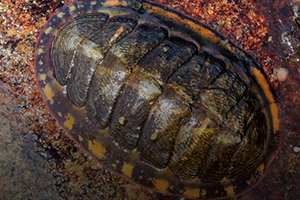Flexible Armor

Although many advancements in protective gear have been made in recent years, elbows, knees and fingers remain the most vulnerable spots in any type of armor. Now engineers have designed a material that is tough enough to provide protection, yet flexible enough that it doesn’t inhibit joint motion.
As is often the case, the engineers took their inspiration from nature – specifically a species of sea mollusk called chitons. These rather inconspicuous creatures are covered with overlapping scales of calcium carbonate to defend against predators. The team studied individual scales down to the nanometer while also looking at chemical composition, crystalline structure and how they function together mechanically. Although the largest of the chiton scales are only a couple of millimeters wide, high-resolution x-rays enabled engineers to create a three-dimensional image of their geometry. Then they used this information to 3-D print physical models (including some prototype kneepads) and evaluate how different configurations would behave under stress.
Results suggest that the new armor would provide protection against lacerations while offering good flexibility. Applications for these types of materials would be vast – from military armor to athletic gear and even industrial protective equipment.
For information: Ling Li, Virginia Polytechnic Institute, Department of Mechanical Engineering, 635 Prices Ford Road, Blacksburg, VA 24061; phone: 540-231-6045; email: lingl@vt.edu; Website: https://vt.edu/ or https://view.joomag.com/momentum-the-magazine-for-virginia-tech-mechanical-engineering-vol-4-no-4-winter-2019/0870263001578944902?short